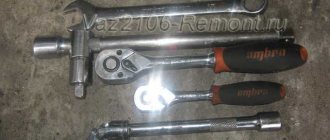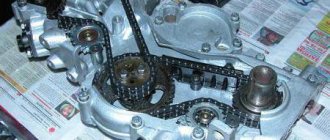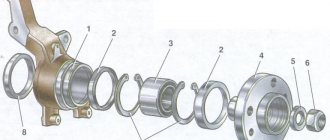For some, cars are a means of transportation, while for others, they are a means of self-expression. The reasons why you decide to reupholster the ceiling can be different: the desire to change the interior to your liking, a coating that has become unusable, persistent dirt, an accident and expelled airbags, loss of shape, peeling of fabric. Before deciding to reupholster the interior, it is advisable to understand in detail the issues of technology and choice of materials. At first glance, there is nothing complicated about reupholstery, but there are a number of features that need to be taken into account. If you decide to entrust this operation to a professional, then knowledge of the nuances will help you control the work of the master.
Procedure for reupholstering the interior
In order to change the car ceiling upholstery, you need to carry out a number of operations:
- dismantling the ceiling from the car;
- cleaning the ceiling from the old layer of upholstery;
- Troubleshooting the ceiling frame, do-it-yourself repairs;
- selection of material and color, purchase of the required quantity;
- preparation of the ceiling frame, repair and degreasing;
- pasting the ceiling with material;
- installation of the ceiling in place;
- assessment of the master's work.
Removing the ceiling and installing it in place must be carried out in full accordance with the above algorithm, otherwise a high-quality result will not be achieved
Removing the ceiling
Disassembling the ceiling in the cabin is not an activity for temperamental car enthusiasts. Patience and care are required to avoid damaging the fragile roof frame, wires and fasteners.
The procedure will differ depending on the make of the car. The exact location of fasteners, wires and the method of dismantling the ceiling are indicated in the repair and operating manual for a specific car model, but there are a number of rules and general recommendations. Compliance with them will reduce the risk of damage during dismantling.
Video: example of ceiling removal
Dismantling proceeds in the following order:
- We examine the ceiling. What we pay attention to: the presence of backlight bulbs, whether the pillar panels interfere with the dismantling of the ceiling, whether there are visible clips and how they are arranged, how the side ceiling handles are attached.
- In most cases, you will need to remove the panels that cover the posts. It is also advisable to drag the panels to match the color of the ceiling - it will look original. To remove the struts, you will need to unscrew the seat belt fastenings, move away the rubber seals, and find the hidden screws. To prevent “crickets” from occurring, the panels are mounted on self-latching connectors. Therefore, you will have to carefully, without fanaticism, pry them off with a screwdriver so that the connectors come out of their sockets.
- If the car has a hatch, you need to disassemble the seals around it, as well as remove the panel that covers the hatch. We will also drag this panel.
- We remove the interior lighting, if any - the heater or audio system control panels, visors and ceiling handles. It is important to identify the location of hidden screws and not damage the plastic parts.
- We find hidden elements of ceiling fasteners, they can be screw, “ruffy”, and also spacer. Depending on the type of clips, we select a tool for dismantling - a screwdriver, pliers, scissors or a knife. In most cases, the clips break when pulled out, so you should find out if there are similar ones in available auto stores.
- The order of removing fasteners is from the edges to the middle. If dismantled in the reverse order, there is a risk of breaking the ceiling frame. Get an assistant to hold the hanging edge of the ceiling.
- An important step is to remove the roof from the interior. In station wagons and hatchbacks this is not a problem - it is accessible through the rear door. In coupes or sedans, difficulties arise. You may have to remove the front seats or one door. If you cannot reach the roof through the door, you will have to remove the windshield - and this is an additional cost.
Depending on the type of car clips, we choose the method of removing them.
Before starting work, we determine the place where the removed elements and fasteners will be stored. If all the parts are in a pile, it will be difficult to install them in place.
Cleaning the ceiling frame
The old fabric and foam backing should be removed. The most common method is mechanical. A sharp knife, spatula, and coarse sandpaper will come in handy. If the fabric cannot be removed, try soaking it in 646 solvent. To avoid damaging the frame, it is better to conduct a test test in inconspicuous areas.
The ceiling frame must be carefully cleaned of old foam rubber and glue residues
Frame defects
Cracks, wrinkles, frayed edges, breaks from airbags - the frame should be inspected, all difficult places should be marked with a marker. Based on the existing damage, a decision is made to replace or repair the frame.
It is recommended to repair using epoxy resin and fiberglass. The procedure is as follows:
- on the back side of the frame, the repair site is cleaned with coarse sandpaper;
- a layer of epoxy resin is applied, a fiberglass patch is placed on top and pressed into the resin;
- repeat the operation 1-2 times until a strong layer is obtained;
- On the front side, the damage is cleaned and puttied.
If the frame is badly damaged, it will be cheaper and easier to replace it.
Video: reupholstering the ceiling with airbags firing
Preparing for work
The preparatory stage is no less important than the choice of material and glue, otherwise nothing will work. First of all, you need to remove the ceiling, and this is not easy. Some owners consider it necessary to remove the windshield, but in reality it is optimal to remove the front passenger seat and pull the roof out through the rear door.
Dismantling
First of all, the ceiling is inspected. However, you should not lose sight of important details:
- is there a backlight;
- will the racks interfere with the removal of the ceiling frame;
- whether there are visible clips, including their device;
- how the handles are attached to the ceiling.
As a rule, it becomes necessary to remove the panels covering the racks - they should also be covered in the shade of the ceiling covering. The front elements are secured in self-latching connectors - just carefully pry them with a screwdriver and they will come out of their sockets. There is no need to completely remove the side pillars; just remove the seat belt fasteners and move them slightly to the side.
Next, you should remove the visors and ceiling handles, unscrew their fastenings, and remove the interior lighting. Next, find all the fastening elements of the ceiling covering, and, depending on the type of clips, select the appropriate tool. It could be a screwdriver or a knife. Sometimes it is convenient to use pliers or scissors. They must be removed from the edges to the middle, otherwise you can simply break the frame. Here you will need an assistant - he will hold the hanging part of the ceiling. Then all that remains is to pull it out.
Cleaning procedure
Old material, including foam rubber, must be removed using a solvent and a sponge. When the fabric is not removed, you can moisten it with solvent. It is better to test in advance on an inconspicuous area to avoid damage to the frame. It is worth considering that the new material will stick well only to a rough surface.
Troubleshooting procedure
If there are cracks, wrinkles, frayed edges and other defects, you need to mark all noticed problem areas with a marker. Based on how badly the frame is damaged, it either needs to be repaired or a new ceiling is purchased. Repairs are carried out using epoxy resin, fiberglass, and the algorithm is as follows:
- On the back side, the damaged area is protected with sandpaper.
- Apply a small layer of resin and place a fiberglass patch on top.
- The procedure must be repeated once or twice so that a strong layer is formed.
- Now you can move on to the front part of the frame - clean the damaged area and putty.
If the frame is severely damaged, the above manipulations will be of no use - it’s cheaper and easier to simply replace it.
Selection of material for reupholstery
The material for upholstering the car interior ceiling has the following properties:
- elasticity;
- strength;
- environmental friendliness;
- non-flammability;
- durability;
- cleanable;
- have a wide range of colors that are resistant to fading.
Video: expert advice when choosing fabric
The market offers a variety of interior reupholstery options. Most Popular:
- automotive leather;
- eco leather;
- Alcantara;
- flock;
- carpet
Automotive leather is considered the most exclusive and expensive upholstery option. It is made from natural raw materials - cattle leather. Automotive leather is thinner than shoe leather, but thicker and stronger than haberdashery or furniture leather. During processing, the leather is covered with a layer of polymer material, which adds practicality and durability to the leather. Natural leather has two disadvantages: it doesn’t stretch well and is expensive. Therefore, it is better for a novice master to postpone this option, since a mistake will be expensive.
Eco-leather is cheaper, but looks the same as the real thing. Therefore, if you want to sheathe the ceiling, it is better to use it rather than natural leather. Eco-leather is made from fabric on which a layer of PVC or polyurethane is applied. When choosing, you should pay attention to polyurethane leatherette, which does not wear out and stretches well.
Alcantara is a popular material that is used instead of leather in car interior trim. This material is an artificial microfiber fabric that looks like suede. Alcantara was invented in Japan specifically for finishing the interiors of yachts and cars. The composition includes polyester, polyurethane and cotton. Thin interwoven fibers allow the material to stretch perfectly in all directions and also to adhere well. There is even an option on sale with an adhesive layer already applied. Alcantara is easy to clean, and over time retains its original appearance and does not wrinkle during use. In many respects, this is an ideal option for finishing a car interior. The downside is the price, which rivals that of real leather.
Another modern technological material is flock. This fabric is produced by spraying small fibers onto a base. A special glue holds the fibers together. A special feature of this material is its maintainability - if you have a special flock sprayer, you can repair a scratch or burn, or even paint a picture with multi-colored pile. The disadvantages of flock are that it does not tolerate exposure to solvents or alcohol cleaners.
Carpet is the most affordable and popular material for car ceiling upholstery. This is a non-woven material that resembles loose felt in appearance. Initially, the casings of audio speakers or podiums for speakers were covered with carpet. Due to its low cost and excellent performance properties, this material has gained popularity among car enthusiasts. Dense and thick carpet is used for car mats, and thin carpet is used as upholstery.
Carpet is widespread and can be purchased at any specialized store.
Photo gallery: materials for ceiling cladding
Stitches on the leather add relief and charm to the car ceiling
Eco-leather will help create an expensive appearance in the cabin
Carpet for budget cars: simple, but tasteful
Semi-matte splendor - Alcantara in the car interior
The flocker will help you create any three-dimensional patterns on the ceiling
There are other options for finishing the ceiling in a car - velor, traditional fabric. However, they are used less and less, since the above materials are more suitable for use in a car.
Purchase of materials
We’ve decided on the type of fabric - it’s time to go to the store to buy. But first we need to measure the dimensions of the ceiling and determine the need to paste the racks. When purchasing fabric, you should take into account a 5-10 cm allowance on each side of the part, as well as the fact that the fabric should be glued to the part without joints, in one piece.
Having purchased the fabric, we select the appropriate glue. There are different types of glue; before gluing, be sure to do a compatibility test of the fabric, roof frame and glue.
The following options are possible:
- glue No. 88 “Moment” is an excellent glue, it applies well and holds the fabric tightly. A day after pasting, you can smell the solvent, but after a while it becomes safe for health;
- special glue that can be applied using a spray gun. Unlike Moment, it has a liquid consistency. If you have a spray gun and a compressor, this is an ideal option, since it is easier to apply a thin, uniform layer with a sprayer;
- Spray fabric adhesive is a popular option. It is more expensive than the first one, but much more convenient, the layer turns out even. High-quality glue in a can is an excellent option for a novice craftsman;
- hot melt adhesive in spray form. It is applied to the fabric and frame and dries. After this, the fabric is laid on the frame, heated with a hairdryer and rolled with spatulas or rollers. After cooling, the fabric holds up well. This method is practiced by professionals, as it allows you to achieve excellent results with minimal effort and time. Hot melt adhesive is usually more expensive and requires a hair dryer with temperature control.
Video: expert recommendations for choosing glue
Ceiling material
The first thing to do is to choose the material for reupholstering the car ceiling. Today, the choice is simply huge; the ceiling can be upholstered with flock, carpet, Alcantara, natural or artificial leather, or fabric can be used. They all have their own merits, and making a final decision can be difficult. On average, it takes at least 5 square meters to reupholster the ceiling and racks. m of material, be it leather or fabric.
Automotive leather
Perhaps the best material that you can choose for upholstering a car ceiling with your own hands is automotive leather. The list of its advantages is impressive:
- it is strong, durable and abrasion resistant;
- not afraid of open fire;
- it cannot be damaged by chemical compounds used to clean the interior;
- not afraid of water;
- does not deteriorate from temperature changes and high humidity.
Perhaps the only drawback this material has is its high price, so not everyone can afford it.
Ecological leather
As an alternative to natural leather, you can use artificial leather to reupholster the ceiling. This material also has very high performance characteristics, but is much cheaper. Here are its advantages:
- it is easy to care for, you just need to wipe it periodically with a slightly damp cloth; you can use ethyl or ammonia to remove greasy stains;
- does not crack at low temperatures;
- does not get wet;
- does not wear out;
- the surface is smooth and soft;
- rich color range;
- long service life;
- low cost.
Externally, eco-leather differs little from natural leather, so it can be used to give the car interior an equally impressive look. In terms of performance and quality characteristics, it ranks second among materials used for car interior finishing.
Alcantara
Alcantara, or faux suede, is a synthetic fabric made from ultra-fine fibers. Outwardly, it really resembles suede. This fabric is quite often used in auto tuning, for the manufacture of various inserts in the interior of the cabin and seats.
Alcantara has deservedly earned the title of “breathable” material - air passes through it unhindered. The advantages that Alcantara has allow us to classify it as one of the best options for do-it-yourself interior reupholstery:
- has a pleasant appearance and is pleasant to the touch;
- long service life without loss of quality (does not wear out, does not fade, does not stretch);
- not afraid of temperature changes and high humidity;
- wide choice of colors.
Flock
This material is not used for reupholstering car interiors with your own hands as often as the previous ones. However, it has a number of advantages that make it recommended for use:
- attractive appearance, variety of colors and textures;
- high wear resistance;
- noise-absorbing properties;
- ease of care.
Re-upholstering the ceiling with flock will require, in addition to glue, the use of a flocking agent and a degreasing agent, i.e. is associated with additional costs.
Carpet
Finally, you can use carpet to reupholster your car ceiling with your own hands. This is one of the most affordable synthetic materials. In addition to the price, it also has other advantages, namely: it is wear-resistant, does not fade, is not afraid of mold, and acts as an additional heat and sound insulation layer.
Work procedure and valuable tips
The ceiling frame has already been cleared of the remnants of old fabric and foam rubber. You can sand it with 80-120 sandpaper for better adhesion. Before gluing, you need to remove any remaining dust and grease from your hands - we use degreasers, but it is not recommended to apply a lot - if the composition saturates the top layer of the frame, it can cause delamination of the material. Therefore, we are testing this method in a hidden area.
Pasting the frame with material
The ceiling has been laid on the table, fabric has been purchased, and a jar of glue has been opened. Let's get started!
Safety precautions require the use of safety glasses, a respirator and rubber gloves. It should be noted that glue that gets on the front surface of the ceiling will spoil the appearance and will not be cleaned off, so we apply the glue with rubber gloves and smooth the fabric without them.
Using a brush, apply a thin layer of glue to the frame area. We wait for a while according to the instructions, lay the fabric and press it in order, paying more attention to bends and indentations. A small roller, a plastic spatula, fingers and a cloth will help you press the fabric. It is important that the layer of glue is small and uniform; it is not advisable to rub the same place with your fingers - it can leave a stain.
You should not cover the entire frame with glue - there is a risk of not having time to press the fabric. Therefore, we apply in strips of 30–40 centimeters, this slowness will allow us to avoid mistakes.
The fabric at the edges can be cut along the edge with a sharp knife, or it can be folded onto the back side of the frame by 1-2 centimeters, cutting it with “teeth”. In this case, the fabric will hold up better. However, it is worth considering that installing the ceiling will be more difficult - it will become wider by the thickness of the fabric.
Video: plywood ceiling of a car in a workshop
What mistakes can a novice master make:
- applying a large amount of glue. It can saturate the fabric and protrude from the front side, ruining the appearance;
- violation of instructions for using glue. The glue has not set sufficiently or has dried out. In this case, the fabric will lag behind;
- poor fabric pressure, air bubbles;
- glue or dirt getting on the surface of the fabric;
- lack of material for pasting. Fabric laid crookedly at the beginning of work may “go” to the side at the end;
- poor quality finishing of frame edges.
The ceiling is glued - we give it a soak, the time of which depends on the instructions for using the glue. After this, we proceed to installing the ceiling.
Ceiling installation
To mount the ceiling, you must first carefully place it inside the car. Practice shows that it is easier to remove the ceiling from a car than to install it in place. Therefore, you should use the services of an assistant and wear clean gloves. We put the ceiling in place and fasten it. An assistant must support the sagging parts of the ceiling, preventing the frame from breaking or bending. If this is not done, wrinkles or folds will appear that will spoil the appearance of the finish.
It is better to select the fasteners in advance to match the color of the trim so that it does not stand out. It is also better to replace clips that are broken during disassembly. When tightening the screws, you should be extremely careful; a broken screwdriver will scratch the plastic or fabric.
Evaluation of work and rewarding of the master
The critical stage is acceptance of the completed work. A new ceiling in a car always looks nice, but don’t relax - we must look at all the shortcomings, loose spots, and dirty spots. We correct them if possible.
If you did the work yourself, be sure to reward yourself with a good emotion; if the work was done by a professional, in addition to money, you can leave a good review of his work, tell your friends about the talented master.
Installation of a car ceiling needs to be done only by two people: then the work will be done carefully
DIY materials for repairing car ceiling trim
The upholstery of a car's interior wears out quite intensively during use. This also applies to the ceiling trim. Over time, finishing materials darken, fade, become clogged and crack. The most intensive wear occurs in the case of smoking. At the same time, the material is also saturated with odor. However, even with careful operation, over time, the ceiling of the car will need to be reupholstered, for example, if it is sagging.
First of all, you need to choose the material for the roof. There are several options: fabric, Alcantara, leather of artificial and natural origin. In any case, reupholstering the ceiling in a car requires approximately 5 square meters. m.
Leather
This material is considered the most suitable for re-upholstering the ceiling in a car with your own hands. Its advantages include high strength, resistance to abrasion and the effects of water, fire, detergents, moisture, temperature changes and the resulting durability, as well as ease of maintenance. The main disadvantage is considered to be the high cost. Artificial leather is an analogue of natural leather, therefore it is similar to it in many respects, as well as in appearance. At the same time, this material has the advantage of lower cost.
Alcantara
It is a synthetic fabric consisting of ultra-fine fibers. This material is considered an artificial analogue of suede: it is characterized by high durability, pleasant appearance and texture, and a wide range of colors. A special property of Alcantara is air permeability.
Flock
This fabric is not as widespread as a material for ceiling cladding with your own hands compared to the options discussed above. This may be partly due to the slightly more complex technology of reupholstering the ceiling in a car. The advantages of flock include resistance to wear, ease of maintenance, attractive appearance, noise-absorbing properties, variety of textures and colors.
This fabric is one of the most affordable among synthetic ones. Its advantages include wear resistance, resistance to mold and fading, noise and heat insulation properties.
As for the color of the ceiling, black is the most common. This is explained by the fact that, firstly, many contaminants are barely noticeable on such a ceiling, for example, such as black deposits from smoke, secondly, many cars have a black or dark interior, with which the black ceiling is combined, and thirdly, black material easier to clean. Light-colored fabric is not as practical to use as black material, but is also suitable for finishing the roof.
This is interesting: How to remove the gearbox of a VAZ classic
Fabric of bright colors is used much less often in the car. Firstly, such material will not match the interior trim unless it is covered with fabric of the same color. Secondly, the bright lining of the car’s ceiling and other interior elements tires the eyes. Therefore, it is best to cover the ceiling in a car with fabric in black or pastel shades.
To glue most of the materials considered to the ceiling with your own hands, all you need is glue, a hair dryer and a leather roller. Only flock requires a degreasing agent and a flocker.
88 is used as glue. Some people believe that it is possible to reupholster the ceiling with Moment, but experts say that this is unacceptable, since this glue emits toxic substances when exposed to sunlight.
You can also cover the ceiling using aerosol glue, but to use it correctly you need to read the instructions.
- You first need to prepare the tools and purchase sufficient quantities of material.
- In addition, it is advisable to find an assistant, since it is difficult to cover the ceiling alone, which will be clear from the description of the technology.
- Performers who do not have experience in this type of work should practice, for example, pasting over small elements such as door handles or inserts.
- To glue the fabric to the ceiling with your own hands, you should use cotton or cellophane gloves to avoid the appearance of fingerprints.
Reupholstering a car ceiling begins with dismantling the old material. For ease of work, the front passenger seat can be removed. You can also remove the ceiling by removing the glass. First of all, additional roof elements such as handles, visors, lampshades, and plugs are removed. Then remove the material and remove any remaining glue and foam using a hard sponge and solvent. After this, it is advisable to treat the surface with sandpaper. This will allow the material to be tightly glued so that it does not come off or sag.
Next, the ceiling of the car begins to be covered. The glue is applied in the center in a strip 10 cm long. The central part of the fragment of material should be glued to it. Continue gluing to the sides, applying strips of glue every 10 cm. During the work, you need to monitor the bends of the working surface. You should glue the fabric as firmly as possible so that the ceiling does not sag in the future. In this case, bends and recesses are places that require special attention. One stretches the fabric, and the other smoothes it. The edges of the material need to be folded and glued to the back side, and the excess is cut off. Finally, you need to make holes for the bolts of additional elements. After this, the ceiling is installed in the salon.
If the roof material is sagging, it is recommended to try treating it with a hairdryer, otherwise you will have to cover the ceiling again.
Exposure to moisture can cause the material to sag. Therefore, you should check the tightness of the roof. It is often mentioned that the ceilings of cars with a sunroof sag. If the material is sagging but not damaged, you can use it for reupholstery. In addition, you can make a ceiling with a starry sky effect. Most cars do not have this option.
This is interesting: Error code P0171 - mixture too lean
To create a starry sky, you will need the following materials:
- some kind of fabric (usually dark);
- glue;
- LEDs;
- wires;
- capacitor;
- stabilizer;
- resistors;
- switch;
- diode.
Cutting devices and clothespins are used as tools. When creating a starry sky, you can choose materials at your discretion (type and color of fabric, size and color of LEDs). The above is just a general list of materials for the starry sky ceiling.
Making a starry sky is much more difficult than covering the ceiling with new material, since this will require electrical engineering knowledge. The starry sky must not only be created, but also carefully calculated to ensure durability. However, this is a very rare and spectacular accessory that gives the car exclusivity. It is enough to note that the Rolls Royce Phantom is equipped with a starry sky ceiling. This type of car ceiling lining provides a wide range for creativity.
Some workshops create starry sky ceilings to order, and some users make them with their own hands, selecting the parameters they desire. Therefore, everyone has the opportunity to receive or make a unique starry sky. So, you can cover the ceiling with any material, vary the number of LEDs, their brightness, size, color combinations and operating mode.
Car ceiling painting
If the ceiling in your car has acquired an unpleasant color over time or after cleaning, do not rush to re-tighten it. Perhaps painting will help you.
For a high-quality result, it is best to remove the ceiling. If you don’t have the time or desire to remove it, you can simply paste over and cover the parts that cannot be painted.
You can choose aerosol paint for suede or fabric, or water-based paint, which is applied with a sponge, roller or brush. Plain enamel cannot be used for cars, as it is not intended for painting.
It is best to paint in dry weather; be sure to use personal protective equipment when carrying out work. To make it convenient to paint from bottom to top, it is better to use a spray gun; a spray can may not cope with this task.
The surface must be clean and dry before painting. the paint is applied alternately, in several layers. The quality of painting depends on the skills of the artist.
A well-painted surface looks no worse than a repainted one, and the cost of paint is much less. Therefore, in some cases it is more profitable to try painting the upholstery than reupholstering.
Painting the ceiling with a spray gun will allow you to achieve an impeccable result.











